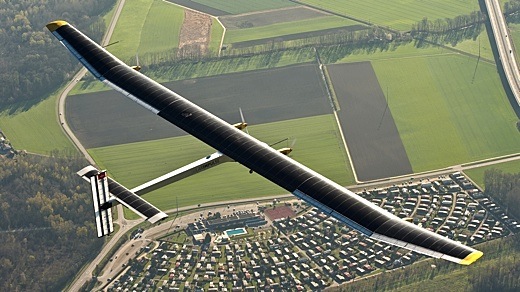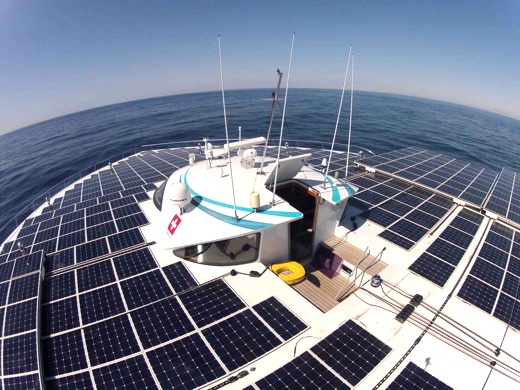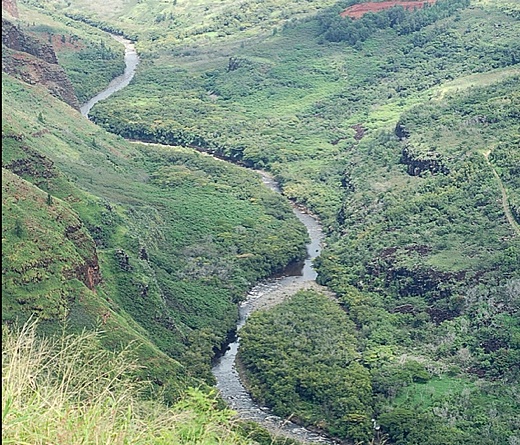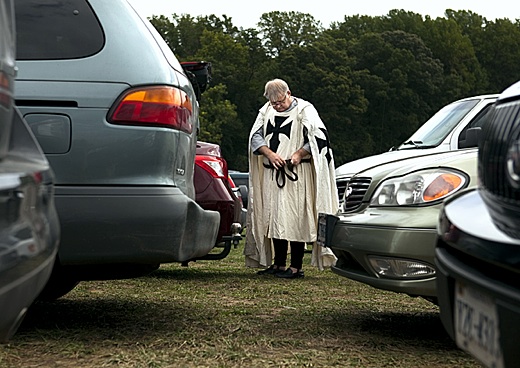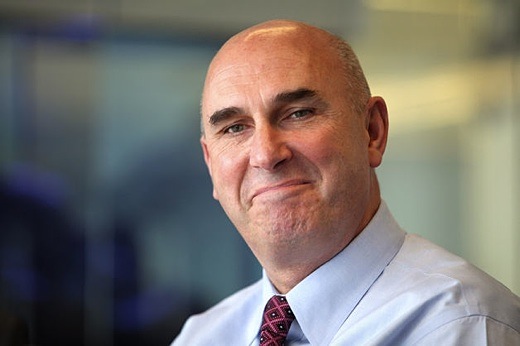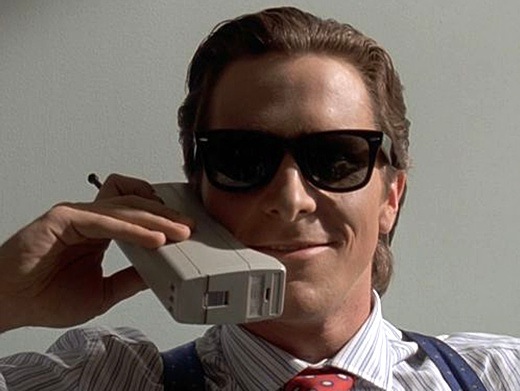SUBHEAD: It behooves Kauai Coffee to work with A&B to remove all DuPont-Pioneer GMOs from the area.
By Juan Wilson on 30 May 2013 for Island Breath -
(http://islandbreath.blogspot.com/2013/05/kauai-coffee-gmos.html)

Image above: Photo taken May 3, 2012 is of DuPont-Pioneer multi-acre open-field test of GMO corn (batch number "516021 DYIN") nestled among Kauai Coffee's cultivated fields. Herbicides were obviously applied to the soil. Photo by Juan Wilson.
As stated in our 3 March 2013 article "GMO's in the coffee fields", Alexender & Baldwin have been leasing acreage to DuPont's GMO subsidiary Pioneer Seed for use in open field GMO testing. There appears to be about 300 acres of land that A&B has allotted to GMO seed operations scattered across several sites amongst the Kauai Coffee 3,100 or so acres that is documented in their 7 March 2011 draft Master Plan.
It was in early March 2013 we saw that plan on display at the Kauai Coffee visitor center museum room.
We asked to Kauai Coffee employees at the visitor center about the test fields among the coffee rows and A&B map indicating where they were. No one seemed to know about the fields or, for that matter, what the mweaning of the map was.
On 28 May 2013 my wife Linda and I were at the visitor's center and noticed that the A&B plan was removed from display.
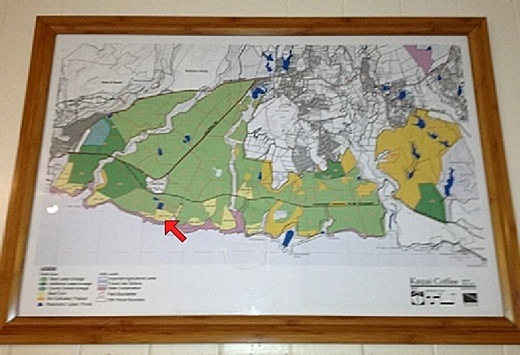
Image above: Photo of A&B plan while it was on display in March of 2013. Note coffee fields with approximately ten corn seed fields identified in light yellow. Also note we placed a red arrow to show location and direction of photo of field test photo at top of article. The white area above is where the old Numila town was and where the visitor center is is located. Photo by Juan Wilson.
Were too many people asking embarrassing queations of Kauai Coffee employees about GMO operations amongst their bean fields? It's a possibility.
As we walked around the visitor's center we noticed that their marker board with the weekly coffee field activities had this odd line.

Image above: Kauai Coffee Weekly Activity Report marker board. Photo by Juan Wilson.
This seems disingenuous. It may not be that the individual fields that Kauai Coffee uses for growing beans are used for GMOs, but there are GMO open field tests that DuPont-Pioneer has been conducting in several sites along the shore adjacent to coffee fields and State Conservation land.
GMO field tests involve multiple applications of various proprietary experimental cocktails of pesticides and chemicals. These are often sprayed on the ground and the plants. It is true that these GMO fields are generally located such that the normal tradewinds will blow the applied pesticides towards the ocean, but that is not always the case with the location and often not with the wind.
It behooves Kauai Coffee to work with A&B to remove all DuPont-Pioneer GMOs from the area, and push A&B to give up GMO seed leasing plans Kauai Coffee wants claim their fields as 100% GMO Free.
Also there website states:
Moreover, they apply chemicals through their drip system to reach the roots of their plants. In short; these are modern industrial farming techniques and not organic farm operations.
We've witnessed at the ends of Kauai Coffee drip-lines soil discoloration with not a blade of grass growing nearby. These areas of moonscape extend into state conservation land that includes the traditional Hawaiian alaloa coastal trail.
We think the DLNR should create a setback buffer area along the Conservation lands within which no chemical or pesticide applications are permitted.
If you want to contact the Kauai Coffee Visitor Center try:
Contact: Darla Domingo
Kauai Coffee Visitor Center
P.O. Box 530
Kalaheo, HI 96741
Office: (808) 335-0813, or toll-free: (800) 545-8605
Fax: (808) 335-3149
Email: kcofvc@kauaicoffee.com
Website: http://www.kauaicoffee.com/
.
By Juan Wilson on 30 May 2013 for Island Breath -
(http://islandbreath.blogspot.com/2013/05/kauai-coffee-gmos.html)

Image above: Photo taken May 3, 2012 is of DuPont-Pioneer multi-acre open-field test of GMO corn (batch number "516021 DYIN") nestled among Kauai Coffee's cultivated fields. Herbicides were obviously applied to the soil. Photo by Juan Wilson.
As stated in our 3 March 2013 article "GMO's in the coffee fields", Alexender & Baldwin have been leasing acreage to DuPont's GMO subsidiary Pioneer Seed for use in open field GMO testing. There appears to be about 300 acres of land that A&B has allotted to GMO seed operations scattered across several sites amongst the Kauai Coffee 3,100 or so acres that is documented in their 7 March 2011 draft Master Plan.
It was in early March 2013 we saw that plan on display at the Kauai Coffee visitor center museum room.
We asked to Kauai Coffee employees at the visitor center about the test fields among the coffee rows and A&B map indicating where they were. No one seemed to know about the fields or, for that matter, what the mweaning of the map was.
On 28 May 2013 my wife Linda and I were at the visitor's center and noticed that the A&B plan was removed from display.

Image above: Photo of A&B plan while it was on display in March of 2013. Note coffee fields with approximately ten corn seed fields identified in light yellow. Also note we placed a red arrow to show location and direction of photo of field test photo at top of article. The white area above is where the old Numila town was and where the visitor center is is located. Photo by Juan Wilson.
Were too many people asking embarrassing queations of Kauai Coffee employees about GMO operations amongst their bean fields? It's a possibility.
As we walked around the visitor's center we noticed that their marker board with the weekly coffee field activities had this odd line.
"All 3100 acres of coffee is 100% GMO free!"

Image above: Kauai Coffee Weekly Activity Report marker board. Photo by Juan Wilson.
This seems disingenuous. It may not be that the individual fields that Kauai Coffee uses for growing beans are used for GMOs, but there are GMO open field tests that DuPont-Pioneer has been conducting in several sites along the shore adjacent to coffee fields and State Conservation land.
GMO field tests involve multiple applications of various proprietary experimental cocktails of pesticides and chemicals. These are often sprayed on the ground and the plants. It is true that these GMO fields are generally located such that the normal tradewinds will blow the applied pesticides towards the ocean, but that is not always the case with the location and often not with the wind.
It behooves Kauai Coffee to work with A&B to remove all DuPont-Pioneer GMOs from the area, and push A&B to give up GMO seed leasing plans Kauai Coffee wants claim their fields as 100% GMO Free.
Also there website states:
At Kauai Coffee, we are fortunate not to have the disease and insect problems that other crops do. Herbicide use has been cut down by 75% through our cultivation practices. And our 3,100-acre coffee plantation is GMO free.Kauai Coffee tells its customers that it does not use pesticides on their coffee beans. As someone who has crossed their fields several times in the last ten years I will add this: Kauai coffee sprays pesticides on fields in certain phases of operations where beans are not present.
Moreover, they apply chemicals through their drip system to reach the roots of their plants. In short; these are modern industrial farming techniques and not organic farm operations.
We've witnessed at the ends of Kauai Coffee drip-lines soil discoloration with not a blade of grass growing nearby. These areas of moonscape extend into state conservation land that includes the traditional Hawaiian alaloa coastal trail.
We think the DLNR should create a setback buffer area along the Conservation lands within which no chemical or pesticide applications are permitted.
If you want to contact the Kauai Coffee Visitor Center try:
Contact: Darla Domingo
Kauai Coffee Visitor Center
P.O. Box 530
Kalaheo, HI 96741
Office: (808) 335-0813, or toll-free: (800) 545-8605
Fax: (808) 335-3149
Email: kcofvc@kauaicoffee.com
Website: http://www.kauaicoffee.com/
.
